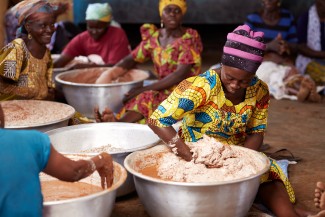Recovery taking a different shape than expected
In April 2020, global markets were in freefall. Governments around the world were debating whether to impose drastic new protectionist measures, and global trade appeared on the way to its steepest decline since the 2008 global financial crisis. While the COVID-19 pandemic was the direct cause of this chaos, the still simmering U.S.-China trade conflict and the collapse in consensus over the future of the World Trade Organization (WTO) exacerbated the concerns.
The pandemic appeared poised to push global trade to the breaking point.
By the summer, the emerging picture was fundamentally different. Despite initial concerns, trade has held up relatively well. But the trade rebound was not a foregone conclusion. Rather, it has been a function of the robustness of trading networks and the resistance of policy makers to imposing major new protectionist measures in response to what is hopefully a transitory phenomenon. The quicker global trade can recover, the better the outlook for a robust economic recovery.
The recovery in merchandise trade began in June. By the end of the year, global COVID-related trade losses had been made up, with growth in merchandise exports up 7.8% year-on-year in December. For 2020 as a whole, the World Bank’s recent Global Economic Prospects report projects a decline in global trade slightly smaller than during the financial crisis year of 2009, although the 2020 GDP decline is projected to be nearly twice as large as 2009. Low-income countries experienced the first aggregate contraction in a generation, and are expected to remain 5.2% below the pre-pandemic projections by 2022.
The relatively better trade performance reflects trade’s resilience during this severe crisis. Global container shipping, a real-time measure of international trade, recovered strongly over the summer and as of 15 February, global trade carrying capacity stands 5.3% higher than at the same time last year. Still, the recovery has not been uniform. While East Asian countries that are well integrated into global value chains (GVCs) have led the way, low-income countries and less globally integrated regions – Latin America, South Asia and sub-Saharan Africa – continue to lag in the trade recovery with imports still down 15 to 20% year-on-year in December.
At the core of the recovery are businesses that have found ways to adapt their supply chains even with production shifts to maintain social distancing, and amid policy uncertainty and new border procedures. Recent World Bank surveys with multinational businesses indicate that over half (58%) have turned to digital technologies to optimize capacity and improve logistics, and a third report mapping the tiers of their supply chains to improve visibility of potential vulnerabilities.
These developments are key.
Although supply chain mapping was well-developed as a technology and managerial practice prior to 2020, even some large firms had not yet implemented best practices and were caught flat-footed when some sources of supply dried up. While some firms have temporarily or permanently changed suppliers, the vast majority of firms are not shifting suppliers or production sites just yet.
The fact that few firms are shifting production locations indicates that the efficiencies firms expect from GVCs continue to outweigh the costs firms expect from future supply chain disruptions. If geographic diversification of suppliers and relocation of production had become widespread, this would have had considerable implications for global trade and investment.
But, as the trade recovery in East Asia has shown, GVCs are difficult to untangle. Recent World Bank research on GVCs shows that firms have made significant investments in relationships between suppliers, producers, creditors and transport operations over the years – investments that firms are reluctant to abandon absent conclusive evidence that they will not be profitable in the long run. Outlays to shift production are especially unlikely in a period of slumping demand, cash constraints and underutilized capacity. Our latest survey of MNE affiliates in developing countries and emerging markets shows that 85% are making no changes to their global investment plans or are delaying investments.
If trade was risky, importing firms should perform better in the crisis. But it is exporting firms that have outperformed. Firm surveys from 53 countries show they are less likely to close, and have higher revenues and larger financial cushions than similarly sized firms in the same sectors. Rather than trade posing a risk, it has made firms more resilient because they have access to other markets and cheaper financing.
While goods trade has held up relatively well, service trade, long viewed as the future of global trade growth, has suffered. Global services exports have declined by almost a quarter relative to last year. Travel and tourism have collapsed with successive waves of the virus. Aggregate data for the United States, Japan, China and Germany shows that travel exports declined more than 70% in December relative to last year. There have been bright spots like IT, which has benefited from a dramatically expanded home-based workforce. But the decline in face-to-face activity has more than offset this.
Goods trade has recovered to pre-crisis levels, but will it grow?
The future of trade is notoriously hard to predict. In the late 1980s, the environment for trade also looked bleak. Global trade was growing only marginally faster than income, and markedly slower than in previous decades, and liberalization efforts had stalled. But in the 1990s, improved communications and logistics, several major trade agreements (NAFTA, the WTO, EU expansion), and liberalization in China ushered in a period of unprecedented trade growth.
If countries take advantage of the crisis to open their economies and improve logistics, the recovery from COVID will be that much stronger. This is especially important in low-income countries, where further global integration, including through trade agreements, will have spillovers for a more inclusive and sustainable recovery. In particular, agreements on e-commerce and digital trade, as well as green trade deals, could support growth and help to restore global cooperation. Just as growing trade tensions in the 1980s led to a rethink of the world trade system in the 1990s, another rethink is needed now to ensure a level playing field, especially for low-income countries, governed by transparent and predictable rules. Reducing trade policy uncertainty will be critical to reviving global investment and growth.
Until the pandemic is over, the global economy will continue to experience obstacles to recovery. Investors are on the sidelines, waiting to see what sectors and markets will recover most rapidly and how trade and investment policies will adapt. Stronger global trade and investment growth would enhance the post-COVID recovery. But it will require governments in advanced countries to adhere to predictable and open policies, and governments in emerging markets and developing countries to use the crisis as an opportunity for market-opening reforms.
This piece is part of a dedicated series to spur dialogue, conversations, and debate alongside the WTO's Aid for Trade Stocktaking event taking place from 23 to 25 March. The piece responds to the event's Theme 4: GVCs, supply side capacity and the pandemic.
If you would like to reuse any material published here, please let us know by sending an email to EIF Communications: eifcommunications@wto.org.


